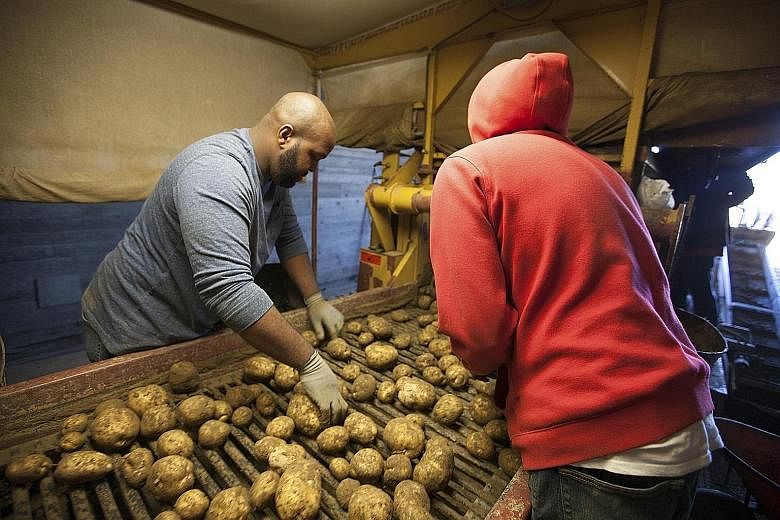NEW YORK • "The earth is gold to farm," said Mr Dean Foster, who learnt to drive a tractor on his family's potato farm in Sagaponack before he was in kindergarten.
As a child, he never questioned going into the family business, which has been growing potatoes on Long Island for generations. "But now, we have an influx of people who realise this earth is gold to build on."
Last year, Sagaponack, a village in the Hamptons, was listed by Forbes as the second most expensive postal code in the country. Not great news for the humble potato farmer.
Brokers estimated the value of the Fosters' 61ha at more than US$100 million (S$139 million) this past summer.
That may seem like a gold strike, but it would have required them to give up the family's legacy. "Our land values have gone through the roof," Mr Foster's sister, Marilee, said. "And most of our adult lives, we've worried."
The answer to their problems has turned out to be vodka.
A law signed in 2014 has eased regulations on small-batch craft-beverage producers. It was a call to the hipsters who had been making bathtub gin, but it was also a call to farmers who had been searching for a way to survive.
"It opened the doors to one of the best value-added products you could bring forward," Mr Foster said, "and allowed us to step up the game."
He is betting the farm on Sagaponacka, the vodka produced in his new Sagaponack Farm Distillery.
Mr Foster has decided to shift his focus from the plate to the martini glass by developing a small-batch premium vodka made with Foster potatoes. He collaborated with Mr Matt Beamer, who has stood at the forefront of the craft beer movement in Utah. "Craft brewers changed the beer world in the last 30 years," Mr Beamer said.
For him, the appeal of the project is the story behind the vodka, which is usually made from grain and does not often have ingredients that distinguish one batch from another.
"The ingredients are unique to this place and have their own terroir," he said. "We're trying to capture Sagaponack."
Unlike the vast majority of distilleries in New York, which source ingredients from farms all over the state, Mr Foster and Mr Beamer are trying to gather all of their ingredients from Foster Farm, where their distillery is located. There, they have total control over the process - growing, harvesting, washing, peeling and then grinding the potatoes for distillation - on the property.
They opened their research and development distillery in May last year. The large still, a tower of gleaming copper, was completed this summer. Soon, it will start producing up to 70,000 gallons of saleable spirits a year. Mr Foster and Mr Beamer hope to have the tasting room open by next summer.
In the meantime, several restaurants and liquor stores in the city and in Long Island are eagerly awaiting the arrival of the vodka with the Sagaponack terroir.
Mr David Loewenberg, who owns three high-end Hamptons restaurants, is already brainstorming what cocktails will best suit the newest vodka on the block.
"I'm sure it will make an outrageous Bloody Mary," he said.
Last year, the Fosters grew 73ha of potatoes. This year, they grew 30ha. Next year, that number will dwindle to 8ha as they focus production on the distillery and a handful of restaurants, eliminating sales on the open market entirely.
The rest of their land will be turned to grain, which will be used to produce more strains of premium alcohol. Wheat, rye, barley, oats and corn will find a place in their soil.
"This is an effort to continue something we see value and purpose in," Ms Foster said. "We don't imagine stopping farming."
NYTIMES

